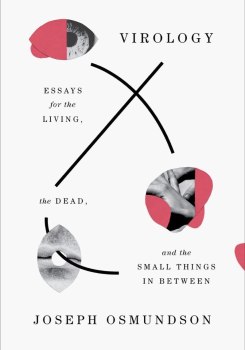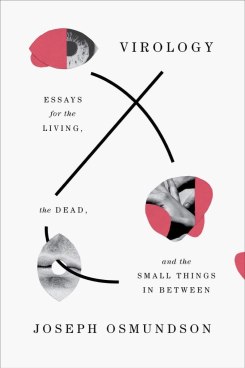The following is an excerpt from Virology: Essays for the Living, the Dead, and the Small Things in Between by Joseph Osmundson.
Disclaimer: When you purchase products through the Bookshop.org link on this page, Science Friday may earn a small commission which helps support our journalism.

Buy The Book
Virology: Essays for the Living, the Dead, and the Small Things in Between
The binary of illness/wellness is always porous, whether or not we notice. In Illness as Metaphor, Susan Sontag wrote, “Everyone who is born holds dual citizenship, in the kingdom of the well and in the kingdom of the sick.”
I used to believe Sontag uncritically. Now I know that the two kingdoms don’t exist; it’s one kingdom, in a quantum state. We are all constantly both sick and well, sick/well, sick and well both, our body and immune system in conversation with a world rich in microbes, viruses, and bacteria, almost all of them either benign or beneficial, countless microbes in me here as I write and in you there as you read.
The quantum state of sick/well. Let me take cancer, that disease so long synonymous with death. Cancer is not a binary. We’re willing to acknowledge this, but only when one has already crossed over into the sick category. Cancer has stages. Stage 1 cancer is still small, mostly easily treatable; stage 4 cancer is aggressive, malignant, deadly. Many prostate cancers require no intervention at all. They are subclinical. We live with them until something else kills us.
How Viruses Have Shaped Our World
Cancer is not black and white but gray, and further, there is no white to begin with. There is no absence of cancer as long as we have a body. We make cancerous cells every day our cells divide, which is to say every day. In order to keep living, and keep making—for example—new skin to push the outside world out, our cells have to divide. With each cell division, a cell will make mutations. Mutations are the raw material of cancer. Carcinogens and sunlight cause cancer because they cause mutations and damage to our DNA. But without cell division, no life. To risk cancer, to make it day by day, is to live. The absence of cancer is death.
So cancerous cells are a normal part of life. In the popular imagination, we see the immune system as mainly protecting us from infectious disease, from bacteria and viruses. But just as importantly, our immune system protects us against cancer, the cells in our own body that mutate to become other, to pose a threat. At almost 40, I’ve certainly had cancerous cells in me, cells that mutate so they can divide and divide and divide. It’s my immune system that finds those cells and kills them so that I, a whole organism, can survive. But because I don’t have cancer doesn’t mean I haven’t had a cancer cell in me. I have, and survived it, so far.
This is why HIV was first called a gay cancer, Kaposi’s sarcoma (KS) skin lesions one of the most visibly obvious signs of advanced disease. HIV kills cells of the immune system—CD4+ T cells to be exact—and the immune system can’t find the cancer anymore, and so the cancers we’d survived for decades become something more deadly, something more visible, a red patch on our skin.
Viral infections, too, are a sick/well. With HIV, HIV-positive individuals can be undetectable, no virus in the blood, no risk for transmitting HIV, a projected life span the same as everyone else’s. And with herpes or chickenpox, once we have an initial infection, the virus is in us always, but dormant. Are we infected then? Yes. But are we sick? Do we have symptoms? No. We are sick/well. If our immune system were—flash—gone, the viruses would all come roaring back.
Our immune system is constantly talking to our viruses and the cancers, the viruses constantly present and able to reactivate (cold sores, shingles), but mostly just there, not just in us, but us. Virus/me, sick/well, cancer/me, always.
One’s relationship to sick/well often has more to do with one’s material circumstances than the circumstances of one’s body. Those living with HIV who are white and wealthy and in New York City may have a very different experience (well) than those living with HIV in the rural South without a healthcare facility anywhere nearby (sick). HIV is material, but it’s not the only thing that is. And it’s not HIV that determines our health. With so many diseases, the fact of the disease itself is often less important than who one is and how one can access care.
But acute viruses, like COVID-19 and influenza, come and go. Here the binary of infected/uninfected holds up to stricter scrutiny.
But even those uninfected live with the virus—living is an active verb—it lives with us, too.
When I wash my groceries with ethanol after coming home from the store, I’m living with COVID-19. When—in June—data on fomite transmission implied that the risk from these types of surfaces isn’t so high, that the air in the grocery store is much more dangerous than the groceries themselves, I decide to stop washing everything that comes into my home in ethanol. I’m living with COVID-19 still.
When I wear a mask. When I stay home. When I don’t stay home and knowingly or unknowingly accept whatever risk there may come, I’m living with. When I get a vaccine, my body is reacting not to a virus but to a part of one, building protection against disease. When I get boosted. I’m living with, a part of the virus is living in me, its memory hopefully long-lasting, the echo of a lost love.
I don’t mean to imply that there are no material differences between the HIV-negative and HIV-positive categories. Or COVID-19-negative and -positive, either. Of course there are. And being HIV- or COVID-19-positive puts one at risk of dying from that virus or from how people perceive it. HIV is a material thing, its genetic material living in HIV-positive people.
Being infected with COVID-19 is different from living with the virus. And living with does not mean we must let ’er rip, let the virus move through our communities unabated. No. Living with COVID-19 means not denying its risk, but trying to minimize the harm for myself and all the humans I care about, which, on my best days, is all the humans there are.
Excerpted from Virology: Essays for the Living, the Dead, and the Small Things in Between. Copyright (c) Joseph Osmundson. Used with permission of the publisher, W. W. Norton & Company, Inc. All rights reserved.
Meet the Writer
About Joseph Osmundson
Joseph Osmundson is a clinical assistant professor of Biology at New York University, and author of Virology: Essays for the Living, the Dead, and the Small Things In Between (Norton, 2022).








